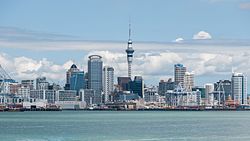Economy of Oceania
This articleneeds additional citations forverification.(August 2009) |
| Statistics | |
|---|---|
| Population | estimated 38 million (2014)[1] |
| GDP | PPP:US$1.67 trillion (2014) |
GDP per capita | PPP:$22,647 |
| During 2003 unless otherwise stated. Most numbers are from theUNDPfrom 2002, some numbers exclude certain countries for lack of information. All values, unless otherwise stated, are inUS dollars. | |
| World economy |
|---|



Theeconomy of Oceaniacomprises more than 14 separate countries and their associated economies.
On a total scale,Oceaniahas approximately 34,700,201[1]inhabitants who are spread among 30,000 islands[citation needed]in theSouth Pacificbordered betweenAsiaand theAmericas.This region has a diverse mix of economies from the highly developed and globally competitive financial markets ofAustraliaand New Zealand to the much less developed economies that belong to many of its island neighbours.
Trade blocs[edit]
The smallestPacificnations rely on trade with Australia, New Zealand and the United States for exporting goods and for accessing other products.
Australia and New Zealand's trading arrangements are known asCloser Economic Relations.Australia and New Zealand, along with other countries, are members ofAsia-Pacific Economic Cooperation(APEC) and theEast Asia Summit(EAS), which may become trade blocs in the future particularly EAS.
This sectionneeds expansion.You can help byadding to it.(June 2008) |
Currency[edit]
The below table summarizes the official currencies of Oceania. Several territories aredollarizedor use a currency with afixed exchange rate.
Economic sectors[edit]
Service industry[edit]
The overwhelming majority of people living in the Pacific islands work in the service industry which includes tourism, education and financial services. Oceania's largest export markets include Japan, China, the United States and South Korea. The majority of people living in Australia, and to a lesser extent, New Zealand work in mining, electrical and manufacturing sectors also.
Manufacturing[edit]
The manufacturing of clothing is a major industry in some parts of the Pacific, especiallyFiji,although this is generally decreasing.
Australia boasts the largest amount of manufacturing in the region, producing cars, electrical equipment, machinery and clothes.
Tourism[edit]
Tourism has become a large source of income for many in the Pacific; tourists come from Australia, New Zealand, Japan, the United Kingdom and the United States.Fijicurrently draws almost half a million tourists each year; more than a quarter from Australia. This contributes $1 billion or more since 1995 to Fiji's economy but the government of Fiji underestimate these figures due in part to an invisible economy inside the tourism industry.
Agriculture and fishing[edit]
Agriculture and natural resources constitutes only 5% to 10% of Oceania's total jobs, but contributes substantially to export performance. The most populous two nations, Australia and New Zealand, are also the most developed and have majority service industries. This dilutes the data from the less developed Pacific Island nations who have major agricultural economies. Most of the Pacific countries (excluding Australia and New Zealand) the primary industry is agriculture. Many nations are still quintessentially agricultural; for example, 80% of the population ofVanuatuand 70% of the population ofFijiworks inagriculture.The main produce from the pacific iscopraorcoconut,buttimber,beef,palm oil,cocoa,sugarandgingerare also commonly grown across thetropicsof thePacific.Fishingprovides a majorindustryfor many of the smaller nations in thePacific,although manyfishingareas are exploited by other larger countries, namely Japan.Natural Resources,such aslead,zinc,nickelandgold,are mined in Australia and theSolomon Islands.Oceania's largest export markets include Japan, China, the United States, India, South Korea and theEuropean Union.
International aid and charity[edit]
Oceanian donor nations[edit]
Oceania's most populous nations, Australia and New Zealand, are both highly developed nations and are large international aid donors. These two wealthy nations share the region with less developed nations which still rely onforeign aidfordevelopment.In the 2007/08 financial year Australia provided $3.155 billion worth of official development assistance, of which $2.731 billion will be managed by AusAID. Every week, each Australian puts in around $2.40 to pay for Australia's aid program, amounting to around 1% of the Australian Federal Government expenditure compared to the 42% spent on social security and welfare.
Oceanian recipient states[edit]
In theSolomon Islands50% of government spending is paid for by international donors; namely Australia, New Zealand, theEuropean Union,Japan and theRepublic of China(Taiwan).
Global trade relations[edit]
This region consists of many trading relations because of the small amount of land and limited resources they have. Many have trading economies and are transitioning to a developed economy and infrastructure.
See also[edit]
References[edit]
- ^ab"Internet Usage and Population in Oceania".Retrieved15 January2010.
